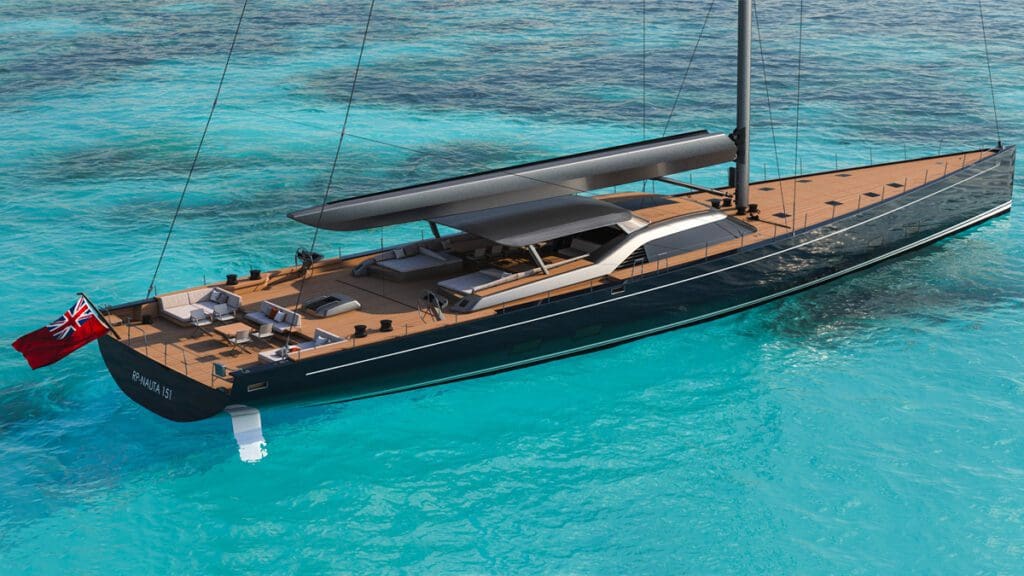Speed, safety, strength and silence: these 4 elements are at the core of the RP-NAUTA 151′, the new one-off bluewater performance sloop with general concept by Nauta Design in build at the Royal Huisman shipyard.
“Combining comfort and safety to explore the world with an extremely lightweight yacht that was competitive in superyacht regattas wasn’t an easy task,” says Mario Pedol, co-founder of Nauta Design in Milan. “The owner wanted a solid, autonomous and safe yacht that was also efficient and modern with a powerful sail plan.” The request came from a repeat client for whom Nauta had previously designed a 34-metre sailing yacht based on a broadly similar brief. The owner was assisted as for the previous time by highly experienced MCM’s Nigel Ingram as Owner’s Representative.
“Working for a repeat client is always very gratifying” says Nigel Ingram “and on this occasion especially so as not only MCM but also Nauta and Reichel/Pugh, all of whom worked on the previous project, received the call from this very experienced client. A strong team to work with Royal Huisman on this very special project.”
This time the owner was ready to step up in size to 46 metres, but he wanted to retain the spirit of his former yacht, including the deckhouse design.
“The deckhouse is essential as it allows to look outside and see the sea while seated in the main salon,” says Massimo Gino, Nauta Design co-founder and partner.
“I started thinking that an aluminium hull weighs 60-70% more than a carbon boat, but the weight of the hull and deck is only about 15% of the total weight of a sailing yacht,” says Pedol. “Our early intuition was that an aluminium construction sailing yacht could be much lighter than the existing aluminium fleet. Royal Huisman supported this vision with enthusiasm and accepted the challenging target of building a light displacement yacht. Extensive research work and calculations, confirmed our initial thought.”
To ensure optimal performance longstanding Nauta partners Reichel/Pugh were selected by the client for the naval architecture. Reichel/Pugh designed and managed a Computational Fluid Dynamics (CFD) study bringing in America’s Cup CFD specialists Caponnetto Hueber and Giorgio Provinciali for the Velocity Prediction Program (VPP) performance analysis. This was a comprehensive hull design study for the R/P-NAUTA 151′ to improve the sea-keeping and motion both motoring and sailing at various speeds and heel angles in different wave conditions, while also improving real and ORCsy rated performance.
What about the deck of the RP-Nauta 151′?
- The wide transom of almost 10 metres includes a hinged section of the teak aft deck that folds out hydraulically in a single movement to rest on top of the beach platform, revealing an elegant staircase that can be raised for launching the crew tender. The aft section further includes two facing sun loungers with L-shaped backrests for viewing aft or athwartships when sailing, an aft facing sofa and a folding coffee table in front of it. The raised aft bulwarks can be used for seating. Two steps lead to the crew companion hatch and the double helm positions.
- The guest cockpit is shaded by the carbon composite hardtop that can be removed in racing mode. There are another two sun loungers with adjustable backrests depending on the direction of heel, a full-size dining table to port and two coffee tables to starboard, both with sofa seating. Unusually, the curved windscreen has three opening sections to provide a through breeze into the cockpit.
- The foredeck features a partially recessed carbon bay for the guest tender that converts into a cozy cockpit with hi-lo table and fitted cushions. Both the forward cockpit and the aft beach club can be covered by awnings supported on carbon fibre poles.
